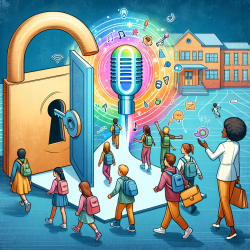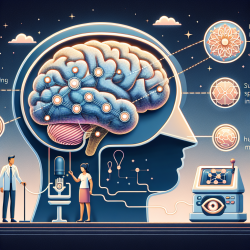Introduction
The study titled "Longitudinal Evaluation of Brain Plasticity in Low-Grade Gliomas: fMRI and Graph-Theory Provide Insights on Language Reorganization" provides significant insights into how brain plasticity can be leveraged to improve language outcomes. This research is particularly relevant for speech-language pathologists and educators working with children, as it highlights the brain's ability to reorganize and adapt, even in the presence of significant challenges such as gliomas.
Understanding Brain Plasticity
Brain plasticity, or neuroplasticity, refers to the brain's ability to reorganize itself by forming new neural connections. This capability is crucial for recovery and adaptation following brain injuries or surgeries. The study conducted by Pasquini et al. (2023) investigates how low-grade gliomas, a type of brain tumor, influence language reorganization over time using functional MRI (fMRI) and graph-theory analysis.
Key Findings
The research identified two patterns of language reorganization in patients with left-hemispheric low-grade gliomas:
- Type 1 Reorganization: This pattern was observed in patients who initially exhibited strong left-hemispheric language dominance, which shifted to co-dominance after surgery. This change is likely treatment-related.
- Type 2 Reorganization: Patients with this pattern showed atypical dominance at the pre-operative stage, which persisted post-surgery. This may be tumor-induced, as the atypical organization was present from the beginning.
Both patterns involve increased inter-hemispheric connectivity, suggesting that this connectivity may be a compensatory mechanism to support language function.
Implications for Practitioners
For speech-language pathologists, these findings underscore the importance of considering brain plasticity in therapy planning. Here are some practical applications:
- Customized Therapy Plans: Understanding the brain's ability to reorganize can help tailor therapy plans to leverage this plasticity, potentially enhancing language recovery and development.
- Monitoring Progress: Regular assessments using tools like fMRI can help track changes in brain connectivity and adjust therapy approaches accordingly.
- Collaborative Care: Working closely with medical professionals to understand the impact of treatments like surgery and chemotherapy on brain function can lead to more effective intervention strategies.
Encouraging Further Research
While this study provides valuable insights, it also highlights the need for further research. Expanding studies to include larger cohorts and diverse populations will help validate these findings and explore additional factors influencing brain plasticity.
Conclusion
The insights from this research can significantly impact how speech-language pathologists approach therapy for children with brain injuries or disorders. By leveraging the brain's natural ability to reorganize, practitioners can develop more effective strategies to support language development and recovery.
To read the original research paper, please follow this link: Longitudinal Evaluation of Brain Plasticity in Low-Grade Gliomas: fMRI and Graph-Theory Provide Insights on Language Reorganization.










